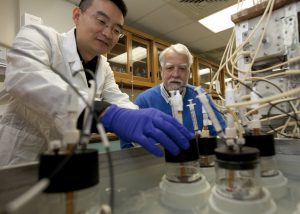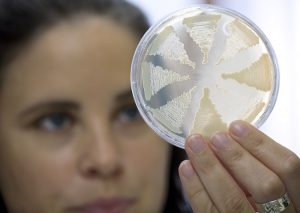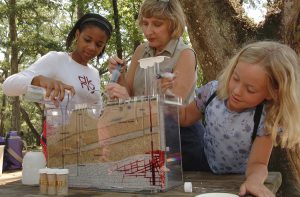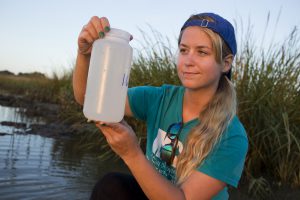I was recently blessed with the opportunity to attend the “Emerging Contaminants in Aquatic Environments Conference” in Champaign, IL. Yes, unfortunately there is such a thing. Anyway, I was thinking it would be nice for me to share some of what I learned at this conference with all of you, so, here I go…
The Welcome
The conference started off with a very nice welcome, one that stuck with me. In Yu-Feng Lin’s (Associate Director of Illinois-Indiana Sea Grant) welcoming address he said, “We didn’t inherit this land from our ancestors, we are borrowing it from future generations.” A perfect reminder as we were about to embark on a series of presentations from researchers around the world on the impacts of emerging contaminants on our aquatic environment. PhDs from Australia, the UK and China, among many others opened my eyes to a world of contaminants I did not know before this conference. Polyfluoroalkyl substances (man-made chemicals used for a variety of stuff), fluoroquinolones (antibiotics), carbamazepine (seizure medicine), galaxolide (fragrance), were just some of the new terms I was exposed to over the course of a day and a half. Don’t worry, I won’t quiz you on these.
Emerging Contaminants
Before I continue, let me explain what this whole idea of emerging contaminants is all about. Emerging contaminants can be referred to as CECs (Contaminants of Emerging Concern) or ESOC (Emerging Substances Of Concern). But, both CECs and ESOC are compounds used to make our pharmaceuticals and personal care products and are collectively referred to as PPCPs.

…I know, I know.
As it was very well summarized in the Florida Department of Environmental Protection report from 2008 “ESOC are particularly challenging for regulatory agencies because of their sheer numbers (there are approximately 14 million commercially available compounds in the United States) and because the majority of them (98%) are unregulated substances with a high degree of uncertainty associated with their environmental fate, transport, and toxicological effects.”
Okay, so, the secret is out that most of the stuff we put in and on our bodies is not regulated. That’s like 50 blogs in itself, but back to what I heard at this conference…
Where do they go?
I learned about the incredible persistence of per- and polyfluoroalkyl substances, referred to as “P-FAS” which are a large group of man-made chemicals used in the production of a number of products from food packaging to electronics, and household products to flame retardants. PFAS are ubiquitous in the environment and are accumulating because of their inability to break down. Similarly, many researchers shared findings of a variety of PPCPs in aquatic environments. People take medicine, yes. People clean their bodies, yes (well, we hope). But people also give tons of medicine to livestock too. Livestock play a huge role in the picture of pharmaceutical use and the resulting pharmaceuticals we are finding in the water.

Water samples showed peaks of antihistamine drugs during allergy season and antidepressants during the winter holidays. Pharmaceuticals tend to be hydrophilic (tending to mix with or dissolve in water) by design which also makes removal complicated, allowing for bioaccumulation and biomagnification. Quick review on this: When an animal eats food contaminated with toxins (i.e. DDT), the toxins accumulate in the tissues of the animal through the process of bioaccumulation. The higher an animal is on the food chain (i.e. shark, alligator, otter), the more concentrated the toxins become in their bodies; that’s biomagnification.

Some researchers were studying surface water, some were studying ground water, and one was looking at the interface of the two. The area where groundwater (think aquifer) interacts with surface water (think lakes and rivers) is called the hyporheic zone. This one researcher (Stefan Krause, University of Birmingham) was looking at how chemical compounds from one can mix with emerging contaminants of the other and what new products are produced as a result. The impacts of warming waters and how that might impact the level of toxicity of some of these chemicals was also explored.

The distribution of emerging contaminants are being found throughout the world’s waters and not only at the surface, but throughout the water column. This was also the case for a study looking at microplastics.
But, wait…
An interesting concept was also revealed about the idea of “regrettable replacements” or “regrettable substitutes”. This is the notion that once we discover a certain chemical is bad, companies are quick to develop a new and different chemical that ends up being just as bad if not worse. This was the case with PFAS and the move to a new chemical called GenX, among others. Yes, it was somewhat of a depressing conference.
Jody Shoemaker, a Research Chemist from the Environmental Protection Agency shared the incredibly complex system and process of the development of standardized methods for testing chemicals of emerging concerns. Here it became clear that while this process is incredibly important, it takes years (three according to Jody), and meanwhile new chemicals are being developed and entering our environment. There is a delay. A dilemma. Once we have research to indicate a chemical is of cause for concern, we then have to come up with standard criteria to test for it, set standards if deemed necessary, develop regulations, then ensure all water quality testing labs have access to the advanced technology required to test for these chemicals. And needless to say, this whole process takes A LONG TIME. I would say this is where the precautionary principal comes into play.

Plastics
Plastics and microplastics (those smaller than 1/8th of an inch in diameter) were also explored during the conference. As alluded to earlier, microplastics are being found throughout the water column. But new research is also showing microplastics throughout karst topography in groundwater and well samples. Jill Bartolotta with Ohio State Sea Grant shared information on the economic impacts of debris removal on beaches as it relates to tourism. She also highlighted that in an effort to reduce one-use plastics, people have enough reusable bags, they just need reminders to bring/use them.
So in the mindset of Yu-Feng Lin’s opening message, we are borrowing water from future generations, but are we returning it in a better or worse state than when we received it? As I stated in my title (Ignorance is Bliss), sometimes I wish I didn’t know these things, but since I do, I want to share my newfound knowledge with all of you.
Funding to attend the Emerging Contaminants in Aquatic Environments Conference was provided by UF/IFAS Extension Administration through a competitive Professional Development Mini-Grant program.
 0
0

